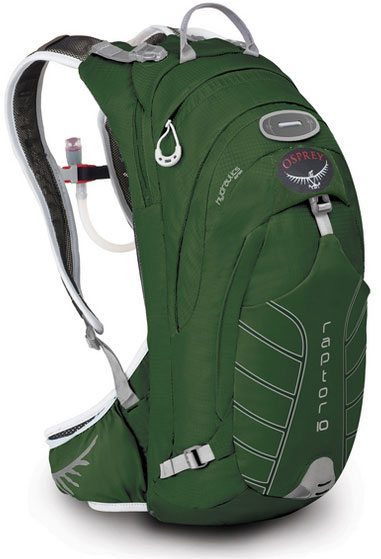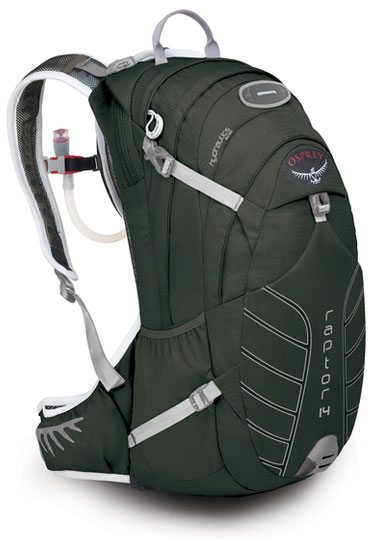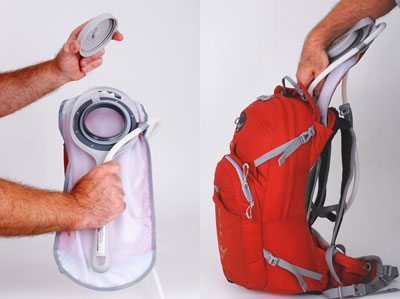 Osprey Raptor 10 and 14 Hydration Backpacks
Osprey Raptor 10 and 14 Hydration Backpacks
Sizes:
Raptor 10: S / M
Raptor 14: M / L
Volumes:
Raptor 10: 8 L / 488 cu. in.
Raptor 14: 14 L / 854 cu. in.
Weights:
Raptor 10: 1 lb., 9 oz. / 710g
Raptor 14: 1 lb., 15 oz. / 870g
Dimensions (H x W x D):
Raptor 10:
 18 x 9 x 7 in.
18 x 9 x 7 in.
46 x 23 x 18 cm
Raptor 14:
18 x 10 x 10 in.
46 x 25 x 25 cm
Days used:
Raptor 10: Too many to count (Two years worth of riding)
Raptor 14: Seven
Rider info: 5’11″, 165 lbs.
Testing locations: All over Colorado; Moab; Jackson; Bozeman; Pemberton, BC
I’m a bit of a pack nerd—a thirsty pack nerd. I think hydration packs are the greatest thing since beer and sliced bread. My first CamelBak Mule, purchased in 1997, was an absolute game changer for me. In the years since then, I’ve gone through a number of packs from CamelBak, Dakine, and Vaude. All were tolerable, with some targeted highlights like armor-carrying straps or great back ventilation, but I also always found something I didn’t like: weight, lack of small bits organization, saggy/sloshy bladders, or fit. With the Osprey Raptors, I’m about as close I’ve gotten to declaring a perfect bike pack.
The Osprey Raptor packs are what you get when people who know how to build incredible, technical backcountry backpacks decide to try their hand at hydration packs. They are jam packed with features like HydraForm Reservoirs, Hydralock, AirScape Suspension, LidLock, BioStretch….
I know, I know. My eyes usually start to glaze over beneath such onslaughts of marketing jargon, but I promise that all of these oddly capitalized words work together to create a supremely high-functioning hydration pack.
I think we should start with what I consider the most significant features, the HydraLock System and HydraForm Bladder.

With the HydraLock System, you get a dedicated bladder compartment that is not affected by cargo volume, and vice-versa. The HydraForm bladder slides inside the compartment and comes with a rigid frame and vertical spine, which acts as handle, hose guide, and stabilizer when nestled into the HydraLock compartment. It’s simple and shockingly effective. As you drink your water, the bladder remains in place and does not sag lower in the compartment and slosh around. (When flicking my bike back and forth, I want to hear and feel dirt ripping, not water sloshing.) An added bonus is that the bladder is always easy to insert or remove from the pack, even if the bladder and/or pack are completely full. A small detail, but a significant one, particularly if a lot of stuff generally stays in your pack. The bladder also has all the modern bells and whistles I want if drinking from plastic: anti-microbial protection, and it’s BPA, PVC, and taste and odor free.
The AirScape Suspension is a ridge foam backpanel that allows for good airflow and a comfortable ride, as does the light, durable, stretchy material that makes up the shoulder straps and hip belt (what Osprey calls BioStretch). Together they make for a nice feel, and the pack disappears on my body with no harsh points of contact. Four load compression straps also help bring the load closer to my body for more comfort and stability.
A height adjustable, stretchy sternum strap also houses a simple but magical feature: a magnet. The magnet pairs up with another one on the bite valve, so the hose is always where you need it and easy to put back—a quick left hand move detaches and reattaches the hose. I don’t know how it all works; it’s pretty much a miracle….
[Editor’s note: /meme]
The LidLock feature lets you easily and securely attach your helmet to the pack for either quick travel or a long, smooth, hot climb. I personally always sport a helmet when going up, down, or across, but it has come in handy when chucking gear into a shuttle rig or friend’s vehicle for a drive to the trailhead.
